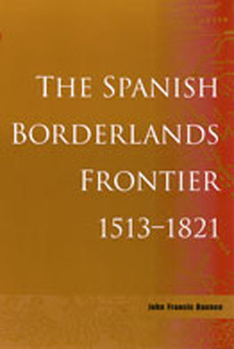The Spanish Borderlands Frontier, 1513-1821
(Part of the Histories of the American Frontier Series)
Select Format
Select Condition 
Book Overview
Spain's frontier movement in North America planted Hispanic civilization in much of the future United States beginning with Ponce de Leon's arrival in Florida in 1513. After describing the travels of the conquistador explorers, it continues through three centuries of mission, presidio, and town development in Florida, Louisiana, Texas, New Mexico, Arizona, and California. As the Anglo-American frontier pushed westward, the Spanish frontier was...
Format:Paperback
Language:English
ISBN:0826303099
ISBN13:9780826303097
Release Date:October 1974
Publisher:University of New Mexico Press
Length:320 Pages
Weight:1.25 lbs.
Dimensions:1.1" x 6.2" x 9.3"
Customer Reviews
3 ratings
The cover was way different then the picture they show in the website
Published by The Spanish borderlands , 4 years ago
I don’t expect the book I got.
Excellent Overview of the History of the American Southwest
Published by Thriftbooks.com User , 20 years ago
Originally published by Holt, Rinehart, and Winston in 1970, I first read Father Bannon's history of "The Spanish Borderlands Frontier" while in graduate school in 1980. I recently reread it to see if it still offered a useful overview of the subject. It does, despite the publication of David J. Weber's excellent "The Spanish Frontier in North America" (Yale University Press, 1992), which covers the same period and location and should be read in conjunction with Bannon's work. The Spanish borderlands was first denoted by Herbert Eugene Bolton, the great early twentieth century historian of the Spanish experience in North America, as the region originally settled by Spain but later incorporated into the United States. Bannon was one of his last students and the inheritor of his scholarly mantle."The Spanish Borderlands Frontier" presents a balanced and thorough history of Spanish exploration and settlement from Ponce de Leon's landing in 1513 to the end of Spain's North American empire in 1821. It is a magisterial textbook that presents an authoritative account of the Spanish colonial period in North America. It focuses largely on the political, economic, and religious activities of the borderlands, and always explores the relationship of the European conquerors to the Native American population. It takes a largely geographical approach, moving from region to region analyzing the development of the borderlands over time. Father Bannon's work is still quite excellent and I applaud the University of New Mexico Press's decision to keep it in print more than thirty years after its original publication. Highly recommended!
A Solid Historical Contribution
Published by Thriftbooks.com User , 22 years ago
As one of the volumes in the Holt, Rinehart and Winston "Histories of the American Frontier" series, this work provides an extensive look at Spanish expansion and activities in what was called by Herbert Eugene Bolton, The Spanish Borderlands, from the 1513 landing of Juan Ponce de León in Florida, to Mexican Independence in 1821. Utilizing an extensive array of primary and secondary source materials, he traces the history of Spanish northward movement out of Aztec Mexico in three separate pronged movements in time-one up the West coast of Mexico; the second up through what is now New Mexico and the last into Texas. He essentially points out a difference between Anglo-American approaches and the Spanish, seeing the areas of Texas, New Mexico, Arizona and California which are presented as basically defensive enclaves, especially after the late 18th century. Importantly, those that moved north into what later became part of the United States did not enjoy the overall freedom that their counterparts further north later enjoyed. A basic thesis is that Spain did not allow the "rugged individualism" so notably applicable to the Anglo-Americans. Initially motivated by avarice, the Conquistador's explored great portions of areas now incorporated into the United States. Nonetheless, after 1543, the Spanish were driven more by a genuine religious concern for Amerindians, influenced greatly by the Franciscan and Dominicans, and somewhat the Jesuits. Hence, using the mission church to convert and pacify Indians, the presidio became a support to an essentially religious motive with a civil end-for which they were quite successful until they met the nomadic Indians from the Plains. Bannon's narrative, at times, seems overburdened with details and names, but this is the nature of historical writing. Overall, this book will be more appreciated by those already possessing a good knowledge of American history; in the end, Bannon effectively carried on the work of his mentor, Bolton, providing a more complete look at a part of history that has been essentially overlooked






